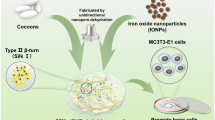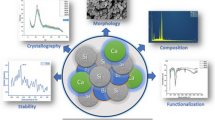Abstract
In the present work, biocomposite foams of bioactive glass along with polyvinyl alcohol and sodium alginate are designed and developed as a potential biomaterial for bone regeneration. These biocomposite foams have a low density of 0.92 g/cm3, providing desired property for bone tissue engineering applications. Biocomposite foams were prepared via surfactant foaming. Scanning electron microscopic characterization revealed pore size of 200–500 μm of the biocomposite foams. When these materials were incubated in simulated body fluid, hydroxyapatite layer formation was observed on the material surface. To confirm the cell viability and proliferation on these materials, MTT [3-(4,5-dimethylthiazol-2-yl)-2,5-diphenyltetrazolium bromide] assay was performed with NIH 3T3 fibroblast cells and the results revealed good biocompatibility with the biocomposite foams. Cell adhesion studies further confirmed the biocompatibility of the scaffolds via cell attachment and ECM production. The optimally synthesized biocomposite foams had a good combination of physical properties with compressive strength of 1.64 MPa and elastic modulus of 18 MPa. In view of the favorable combination of physical and biological properties, the newly developed materials are considered to be suitable for regeneration of trabecular bone.








Similar content being viewed by others
References
Blom A. Mini-symposiums: Fracture Healing (V). Which scaffold for which application? Curr Orthopaed. 2007;21:280–7.
Stevens MM. Biomaterials for bone tissue engineering. Mater Today. 2008;11:18–25.
Nath S, Tripathi R, Basu B. Understanding phase stability, microstructure development and biocompatibility in calcium phosphate–titania composites, synthesized from hydroxyapatite and titanium powder mix. Mater Sci Eng C. 2009;29:97–107.
Roy S, Basu B. On the development of two characteristically different crystal morphology in SiO2–MgO–Al2O3–K2O–B2O3–F glass–ceramic system. J Mater Sci: Mater Med. 2008;20:51–66.
Kathuria N, Tripathi A, Kar KK, Kumar A. Synthesis and characterization of elastic and macroporous chitosan–gelatin cryogels for tissue engineering. Acta Biomater. 2009;5:406–18.
Tripathi A, Kathuria N, Kumar A. Elastic and macroporous agarose-gelatin cryogels with isotropic and anisotropic porosity for tissue engineering. J Biomed Mater Res A. 2008. doi:10.1002/jbm.a.32127.
Nath S, Bodhak S, Basu B. HDPE–Al2O3–HAp composites for biomedical applications: processing and characterization. J Biomed Mater Res B. 2009;88:1–11.
Oki A, Qiu X, Alawode O, Foley B. Synthesis of organic–inorganic hybrid composite and its thermal conversion to porous bioactive glass monolith. Mater Lett. 2006;60:2751–5.
Li Z, Ramay HR, Hauch KD, Xiao D, Zhang M. Chitosan–alginate hybrid scaffolds for bone tissue engineering. Biomaterials. 2005;26:3919–28.
Ren L, Tsuru K, Hayakawa S, Osaka A. Novel approach to fabricate porous gelatin–siloxane hybrids for bone tissue engineering. Biomaterials. 2002;23:4765–73.
Costa VC, Costa HS, Vasconcelos WL, Pereira MM, Oréfice RL, Mansur HS. Preparation of hybrid biomaterials for bone tissue engineering. Mater Res. 2007;10:21–6.
Pereira MM, Jones JR, Orefice RL, Hench LL. Preparation of bioactive glass–polyvinyl alcohol hybrids foams by the sol–gel method. J Mater Sci: Mater Med. 2005;16:1045–50.
Li R, Clark AE, Hench LL. An investigation of bioactive glass powders by the sol–gel process. J Appl Biomater. 1991;2:231–9.
Clupper DC, Gough JE, Embanga PM, Notingher I, Hench LL, Hall MM. Bioactive evaluation of 45S5 bioactive glass fibres and preliminary study of human osteoblast attachment. J Mater Sci: Mater Med. 2004;15:803–9.
Lobel KD, Hench LL. In vitro protein interactions with a bioactive gel–glass. J Sol–Gel Sci Technol. 1996;7:69–76.
Valerio P, Guimaraes MHR, Pereira MM, Leite MF, Goes AM. Primary osteoblast cell response to sol–gel derived bioactive glass foams. J Mater Sci: Mater Med. 2005;16:851–6.
Zhou Z, Chen L. Morphology expression and proliferation of human osteoblasts on bioactive glass scaffolds. Mater Sc-Poland. 2008;26:505–16.
Gougha JE, Jones JR, Hench LL. Nodule formation and mineralisation of human primary osteoblasts cultured on a porous bioactive glass scaffold. Biomaterials. 2004;25:2039–46.
Zhong JP, Greenspan DC. Processing and properties of sol–gel bioactive glasses. J Biomed Mater Res A. 2000;53:694–701.
Morgan EF, Bayraktar HH, Keaveny TM. Trabecular bone modulus–density relationships depend on anatomic site. J Biomech. 2003;36:897–904.
Morgan EF, Yeh OC, Keaveny TM. Damage in trabecular bone at small strains. Eur J Morphol. 2005;42:13–21.
Bayraktar D, Tas AC. Chemical preparation of carbonated calcium hydroxyapatite powders at 37°C in urea-containing synthetic body fluids. J Eur Ceram Soc. 1999;19:2573–9.
Acknowledgements
The work was financially supported by the grants from Indian Institute of Technology, Kanpur, India and Department of Biotechnology (DBT), Ministry of Science and Technology, Govt. of India. Ruchi Mishra gratefully acknowledges the fellowship received from Indian Institute of Technology Kanpur, India for her Ph.D. program.
Author information
Authors and Affiliations
Corresponding author
Rights and permissions
About this article
Cite this article
Mishra, R., Basu, B. & Kumar, A. Physical and cytocompatibility properties of bioactive glass–polyvinyl alcohol–sodium alginate biocomposite foams prepared via sol–gel processing for trabecular bone regeneration. J Mater Sci: Mater Med 20, 2493–2500 (2009). https://doi.org/10.1007/s10856-009-3814-1
Received:
Accepted:
Published:
Issue Date:
DOI: https://doi.org/10.1007/s10856-009-3814-1




